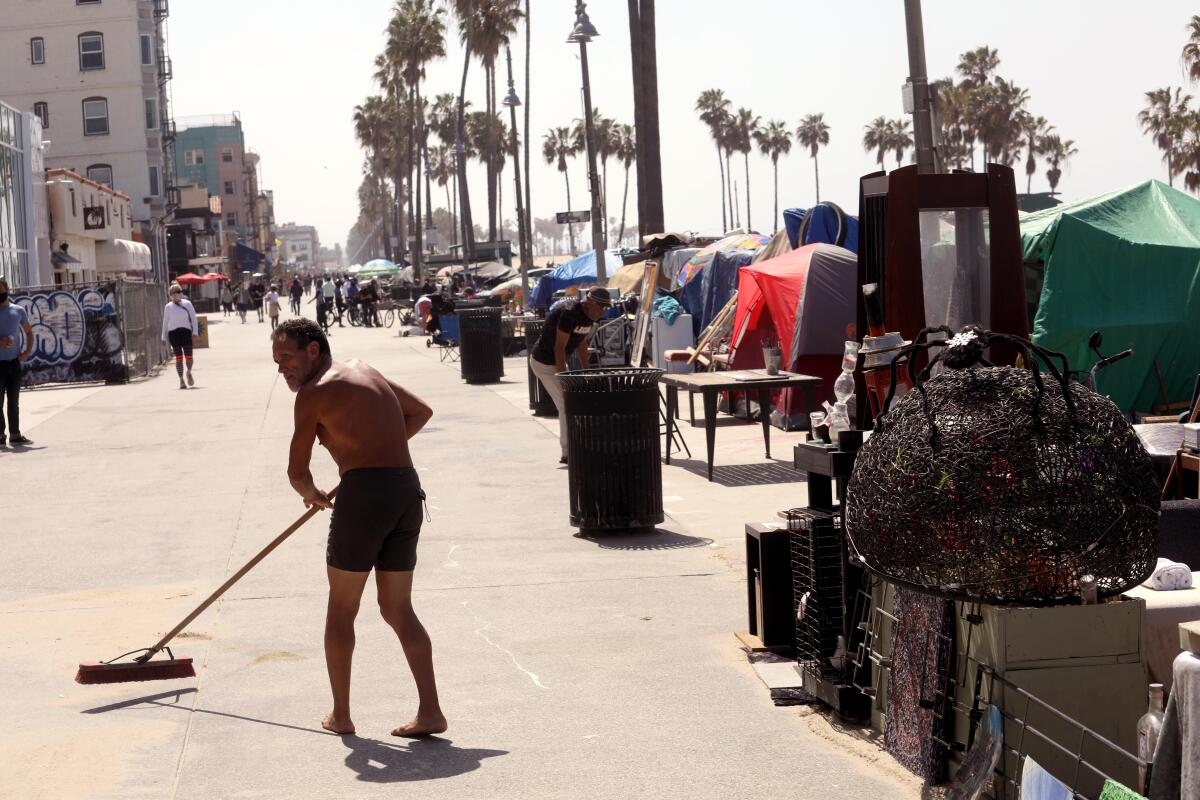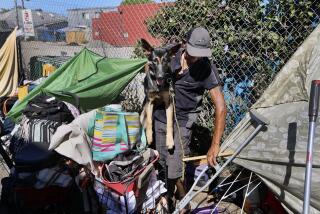Editorial: Venice Beach needs to stop being a campground for homeless people, so let’s get campers housed

Nowhere has the idyll of the California oceanfront collided with the grim reality of street homelessness more than on Venice Beach. Following public health guidance not to disperse homeless people during the pandemic, the city wisely chose not to enforce its ordinances against camping in parks and other public places. As a result, campers settled in at Venice Beach, mostly on a one-mile swatch of ground between the concrete boardwalk and the bike path. Tents also sprang up on parts of the beach and on the shuttered handball courts.
The unhoused residents of Venice Beach have not exactly been welcomed with open arms. Business owners and residents have bitterly complained about trash, incidents of violence and fires ignited by tent dwellers.
Much like Echo Park Lake, where encampments mushroomed until the park was cleared a few months ago, Venice Beach has become a prism through which the public judges homelessness and the city’s response to it. Some residents have railed against L.A. City Councilman Mike Bonin — and vowed to recall him — for not reining in the encampments at the beach and elsewhere in his district. L.A. County Sheriff Alex Villanueva — who has countywide jurisdiction, but who generally is expected to leave the enforcement of laws in the city of Los Angeles to the L.A. Police Department — has shown up at the beach to decry the city’s lack of action on the issue and to say he’d like to see the boardwalk cleared by July 4.
What is certain is that no one should be camping in city parks, including the beaches. With virus rates low in Los Angeles and vaccination rates high, all of Venice Beach needs to be returned fully to public use and kept that way. Bonin has called the encampment situation “intolerable.”
But this isn’t a matter of “clearing” homeless camps and shooing people into neighboring communities. This has to be an effort to house people. And it should not involve a phalanx of police officers, as it did when Echo Park Lake was being closed to camping, or sheriff’s deputies. The only army of people involved here should be outreach workers and case managers with offers of housing or shelter for homeless people, all of whom are suffering the effects of poverty — along with some combination of bad luck, mental illness or substance abuse.
Bonin and Westside service provider St. Joseph Center are implementing a meticulous plan to break the boardwalk area and beach into five zones, each with roughly the same number of tents, and attempt to move people into housing zone by zone, starting with the outermost zones and moving to the middle. St. Joseph Center used a similar strategy to house about 70 people camped on a street in front of the Penmar Golf Course in Venice in 2020.
Dawan Moses, who oversees all of the St. Joseph outreach teams, has counted 141 tents and roughly 200 people. The intensive zone-by-zone outreach will begin this week. Va Lecia Adams Kellum, the chief executive of St. Joseph, expects to move through one zone each week, which will be a challenge, but Adams Kellum knows that beach businesses are reopening and there’s pressure to have the beach and boardwalk area free of tents. The service provider has already been moving people there into housing. In the last few months, 30 people were housed. An additional 12 were housed on Thursday alone.
The success is about more than the outreach, though. It’s also about resources. Adams Kellum expects to have 200 rent vouchers from the city to move people into apartments — not shelters or other temporary forms of housing. The problem will be finding affordable apartments, as well as more funding if the city can’t pay for the vouchers for more than a year. But as Adams Kellum says, once someone is living in an apartment, case managers can help that person apply for a federally funded Section 8 voucher that can be used indefinitely.
Not everyone camped at Venice Beach will get an apartment of their own. Some may be offered rooms for a limited time in hotels bought by the city under the state-funded Homekey program. Others may be offered motel rooms for several months or space in a shared apartment.
As people move out of each zone, those who decline offers will be told they need to leave that zone so that Bureau of Sanitation workers can clean the area. After that, city officials will have to figure out a way to keep Venice Beach free of campers. Bonin says trash cans or bike racks might be installed or activities for the area might be planned. Outreach workers fully expect that campers in the zones who refuse housing offers will move into the zones left to be cleared. And that’s not necessarily a bad thing. That gives people more time to think about taking housing as they see others around them accepting it — and it gives outreach workers more time to persuade them.
Adams Kellum should be given the time needed to carry out her plan. Still, there will probably be people at the end of the process who continue to refuse the housing that’s offered, and they will have to leave the area or risk being cited. But police should wait to enforce camping laws until every homeless person there has been offered housing.
The L.A. Police Department has already issued 770 citations to homeless people on Venice Beach this year alone for illegally camping. That’s enough criminalization of homeless people — at least until they’ve been given a chance to move into housing.
The effort planned by Bonin and Adams Kellum seems like the right way to house homeless people. Some advocates point out that the most vulnerable homeless individuals get overlooked when all the resources are focused on a specific location. Ideally, the city should be looking at individuals as well as encampments. But if St. Joseph succeeds in Venice, the city should replicate this focused and intensive approach to house much of the homeless population sprawling across Los Angeles. The hurdles will be getting enough money and finding enough housing.
More to Read
A cure for the common opinion
Get thought-provoking perspectives with our weekly newsletter.
You may occasionally receive promotional content from the Los Angeles Times.









